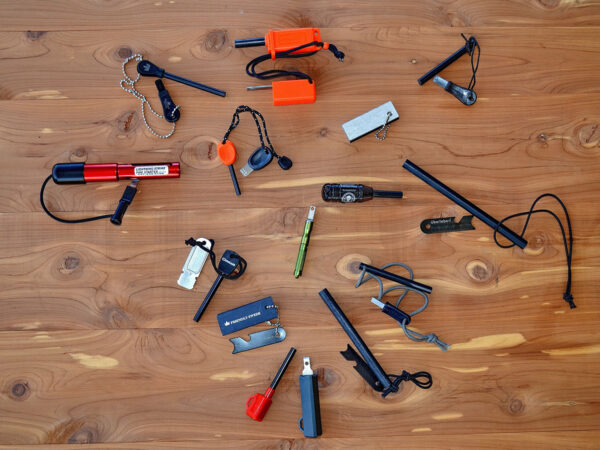FROM SPARK TO FLAME
Learning to control fire was one of early man’s most important accomplishments. He found that by being able to create fire he could keep warn, light the darkness, clear land, make tools, cook food and use it as protection from predators.
Researchers are not sure if the first fire-making was the result of discovering that a spark could be generated by friction, such as a hand drill, bow drill or fire plow, or if it was discovered that a spark could be generated when the sharp edge of a hard rock when struck against iron pyrite rocks. What we do know is that when fire-making was mastered it quickly became a part of man’s daily routine.
Fast forward to the Iron Age and the discovery that the sharp edge of a hard stone such as flint, jasper, obsidian or quartzite when struck against high carbon steel produced sparks faster and easier than all previous methods of fire-starting. The flint and steel kit became a part of history from then until the discovery of friction matches in the middle 1800’s. Slowly in the early 1900’s as friction matches were improved, flint & steel kits started disappearing from home hearths, woodsmen pouches and trappers cabins.

However flint & steel kits didn’t entirely disappear. Even today many woodsmen, re-enactors, and survivalists use flint & steel kits, such as those made by Vern’s Flint & Steel (http://www.vernsflintandsteel.net) , much as it was done in the frontier days of early America.
What Makes Sparks
The question of what actually creates sparks when flint hits high carbon steel or when a striker hits a ferro rod is often raised in survival classes. It is actually a rapid rusting (oxidation) of tiny particles of iron removed from the steel striker, as in the case of a flint & steel starter, or tiny iron particles being quickly shaved from a ferro rod. When the iron slivers touches the oxygen in the air a reaction occurs, the iron rusts rapidly and gives off spontaneous heat, sparks.

Then Came Ferrocerium Rods
As the Industrial Revolution rolled along there was a commercial need for a quick and easy way to ignite gas welders, cigarette lighters, Bunsen burners, gas cutting torches, etc. In the early 1900’s an Austrian chemist invented a rod made up of elements of which most was iron (ferrum) and a rare earth element called cerium. The new invention was called ferrocerium for the two principle elements. Over the years the formula for ferrocerium has been improved, especially with the increased amounts of magnesium for hotter, longer burning sparks. Today most ferrocerium rod’s throw sparks that are about 5500 degrees F., compare that to the sparks thrown by flint & steel which has been measured at about 800 degrees F.
Ferrocerium rods have come to be known by several names. Today ferro rod is the most common name but they are called magnesium rods, firesteels and mischmetal rods because of the increased magnesium and/or rare earth elements added to the alloy blend.
[Back when I wrote my book The Scouting Guide to Survival I elected to call the ferro rod a magnesium rod as that was the term that seemed to be used most by woodsmen, and even some of the ferro rod companies, at that time. By the time the book came out, ferro rod had become the accepted term and I heard from, and still do, a lot of readers telling me how wrong I was. So I stand corrected, it’s ferro rod from now on.]
At this writing ferro rods are not made in the U.S. but primarily in China and Europe. The quality of the rods may vary depending upon the alloy blend, amount of elements used, and the manufacturing process. Since consumers have no way of knowing how a ferro rod is manufactured it is best to purchase a rod, which your life may depend upon, from one of the well established brands. Poor quality rods may break easily, not throw hot sparks, be difficult to get a spark at all and deteriorate quickly.
As you shop for ferro rods you will see that they all basically look alike, they are a black rod of varying lengths and diameters. The black coating on them is to protect them from oxidation and must be removed before using. Rod diameters generally run from 3/32” to 1”. Lengths are from 1 ½ “to as long as 1’. Some rods, such as UST Strike Force (http://ustbrands.com) and Zippo Mag Strike (http://zippo.com) have handles made of plastic that serve to also store the striker. Handles on rods such as the ESEE Fire Kit (http://eeseeknives.com) and Lightening Strike Fire Starter are hollow so that tinder can be stored inside. Many ferro rods made by well know companies such as Ben’s Backwoods, Coghlan’s, Firesteel.com, Self-Reliance Outfitters, Uberleben, and The Friendly Swede come without a handle. The rods, available in several lengths and diameters, simply have a hole drilled in one end and a hard metal striker is attached with a strong cord or chain. Other ferro rods, such as Light My Fire Swedish Fire Steel 2.0 Scout, have a small plastic handle molded onto the rod. (http://lightmyfire.com)
Why a Ferro Rod?
Why would you carry a ferro rod if you carry fresh strike anywhere kitchen matches in a waterproof container, or if you are proficient with flint & steel or if a disposable gas lighter is always with you? I would not suggest you stop carrying these fire-starters but when you consider the merits of a good ferro rod it is an excellent backup to these other fire-starting methods and in many cases is an excellent first choice fire-starter. Matches are useless when wet and limited in supply. A flint & steel kit does not throw nearly as hot of sparks nor do they burn as hot and long as sparks from a ferro rod. Disposable gas lighters can loose gas easily, do not work well at high altitudes and can be difficult to use with cold wet fingers.
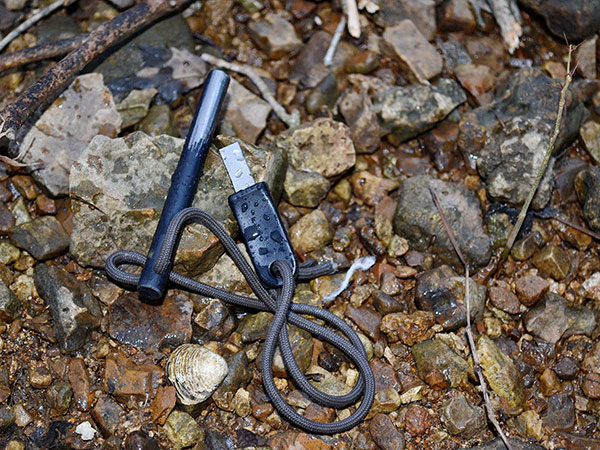
Consider the following positive points of packing a ferro rod:
- It is quick and easy to learn to use.
- Works well when wet
- Once protective coating is removed, almost any hard sharp object can be used to throw sparks.
- Sparks are hot, about 5500 degrees F
- Sparks burn longer than flint & steel sparks
- Easy to aim sparks to tinder
- Abundant supply, 1000’s of sparks from even the smaller rods
- Long life if properly protected
- Good signal at night
- Works at all altitudes
Works well in windy conditions
Which Ferro Rod for You?
Matching a ferro rod to its intended use is a personal choice. For use in a base camp where size and weight doesn’t matter the longer ½” to 1” rods 8” long work well. Currently in my camp I am using a Uberleben 8”X ½” rod. (http://uberleben.com) For a striker I am using a wooden handle triangle machinist’s scraper. This combo, when struck onto petroleum jelly coated 100% cotton balls, starts a fire with the first strike.
For day packs, survival kits, boats, snowmobiles, ATV, etc. match the rod with the size storage container used. Currently in the survival kit I carry with me in my day pack I have a Firesteel.com Armageddon 4”X 3/8” rod which has a predrilled hole in the rod with a 24” paracord attached with a striker. (http://firesteel.com)
In the glove box of my ATV I carry a Lighting Strike Fire Starter. (https://www.lightningstrikefirestarter.com) This ferro rod is in an easy to spot red aluminum case which serves as a handle for the rod. The handle is hollow and in it stored enough Napalm tinder to start 20 fires. The case is a unique design so that the attached striker has an elongated opening that enables the user to strike sparks accurately onto the tinder.
There is an excellent selection of ferro rods available in many sizes and with many features. Just stay with the name brands and take your time to pick a rod that will fit into the storage space you plan on carrying it in.
Care & Maintenance
Ferro rods are relatively easy to take care of once you understand some basics. These rods are not made from rebar-like material. They are a composite made up of elements that will deteriorate over time due to oxidation. The reason the rods look black when you buy them is because the manufacturer paints a black sealer on them to protect the rod until it is used. Once you scrape off the black coat and the bright surface is exposed then it is subject to oxidation. Ferro rods in salt water environments, such as boat survival kits, etc., deteriorate the fastest.
To find out how the experts suggest protecting ferro rods for long life after the rod has been used I went to the experts. Here is what Ron Fontaine of Firesteel.com told me, “The storage life of a ferro rod will depend on how well it is maintained. Just as you would take care to oil/protect a valued weapon such as a knife or firearm, your ferro rod’s lifespan will depend on the care it has received. Every year or so, we’ll get an email from a customer complaining that their ferro rod has rusted on them. Invariably, care has not been taken to protect the rods in question. If the owner just tosses the rod into a gear bag without protection, the oils and moisture in the surrounding textiles will promote corrosion. Also, any small nicks or chips from heavy gear tossed into the bag will also expose any unprotected metal to corrosion. Similarly, if the owner lives in a very wet, damp or salty environment, extra care must be taken to protect the rods. Keep in mind that the same properties that make a ferro rod spark are the same properties that tend towards corrosion and decay. As to what kind of oil to use, we prefer plain old Vaseline. It does the job and can also be used to help start your next fire.”
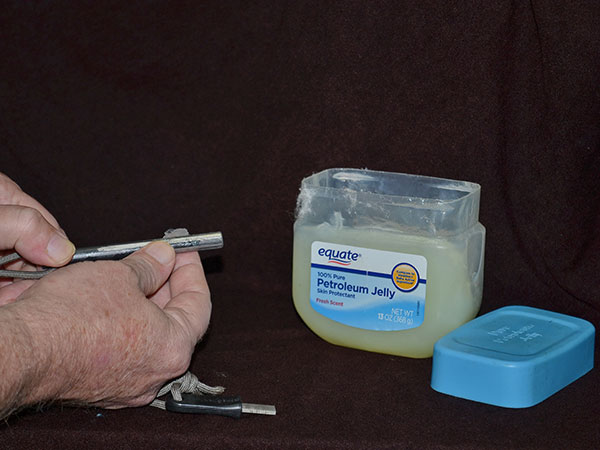
James Gibson, well-known survival instructor and blacksmith tells me that especially around salt water or very wet environments he uses clear finger nail polish to protect his ferro rods. This seals the exposed metals and is easy to remove when the rod is needed.
I have used both methods and they work.
Also, ferro rods should be stored so that they will not be broken. The rods can break if dropped on a hard surface or gear is toss on them.
Good Striker a Must
Even the very best quality ferro rod will not produce sparks unless a hard, sharp edge striker, sometimes called scraper, is used. I have taught survival courses where the students lost faith in their ferro rod due to a weak or dull striker being used.
To get a shower of hot sparks in the first strike, every time, have a hard steel striker with a 90-degree angle on it. Many ferro rods come with a hard steel scraper attached with a cord of some type. Most do a good job but I have seen a few that were too flimsy or soft to cast sparks consistently. When you get a new ferro rod, try out the striker supplied to make sure it works consistently.
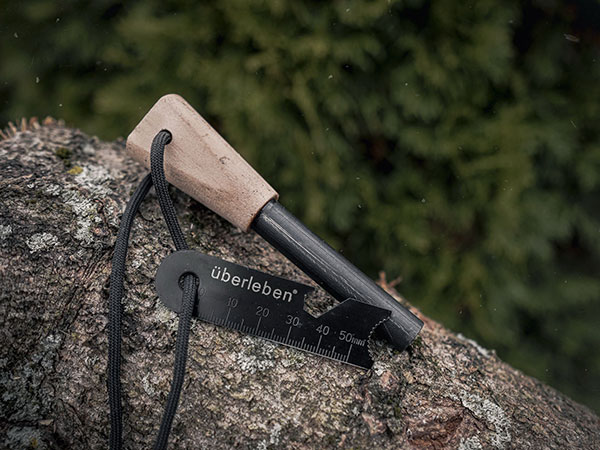
Many experienced woodsmen use the back edge of their belt knives as a striker and while most high carbon knives work I still want a striker attached to my ferro rod in the event I am separated from my knife when I need fire.
Carry High Quality Tinder
The hottest sparks will not start a fire if they don’t fall onto tinder that will catch the sparks and began to burn. Volumes has been written about materials, man-made and natural, that make good tinder so we will not go into that here, however anyone carrying a ferro rod should have with the rod a good supply of proven tinder. To have a ferro rod and a good striker without suitable tinder is to not have fire. Study by actually using, under adverse weather conditions, the tinder’s you like and when you find a winner keep a supply with the ferro rod.
Practice, Practice, Practice
As I visit woodsman camps and survival courses I am amazed at how many outdoorsmen purchase a ferro rod and never really practice using it. While learning to use a ferro rod is a fairly easy process it must be done to make sure you have a quality rod, a striker that will get the job done quickly and easy, and that the tinder you carry will work in all weather conditions. Without actually practicing, these are unknowns and can get you into trouble when suddenly they are the difference in life or hypothermia.
Also practice teaches you how to use the striker to get a hot shower of sparks onto the tinder the first strike. The right angle of the striker must be learned as must the right stroke to put sparks on the tinder without knocking the tinder away. I have used some strikers that have one edge that is sharp and will throw a shower of sparks while the other edges will not. Get to know your striker.
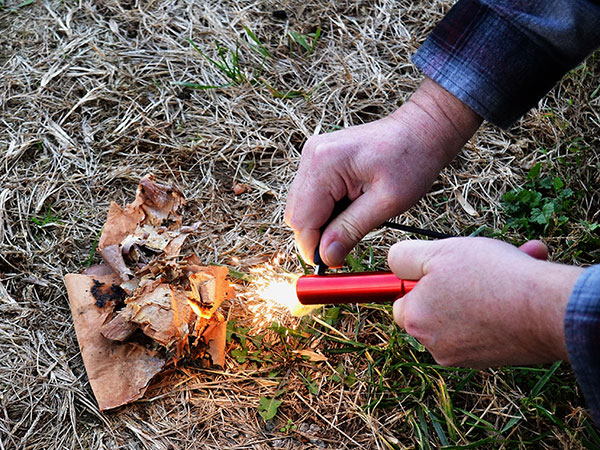
Practice not only getting the sparks to the tinder but getting the tinder bundle under the kindling and getting a fire going in all types of weather. Once you master this then will you learn the value of using the ferro rod to turn sparks into flame.
For More Information see:
Vernsflintandsteel.net
Bensbackwoods.com
Coghlans.com
Doanfirestarters.com
ESEEknives.com
Firesteel.com
Lightingstrikefirestarter.com
Lightmyfire.com
Selfrelianceoutfitters.com
Uberleben.com
Ustbrands.com
Zippo.com
Amazon.com/frendlyswede

